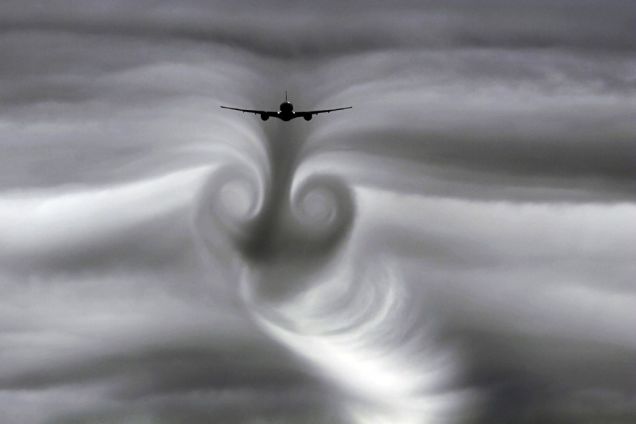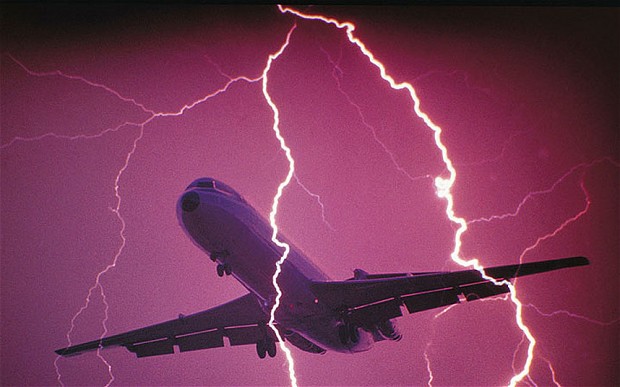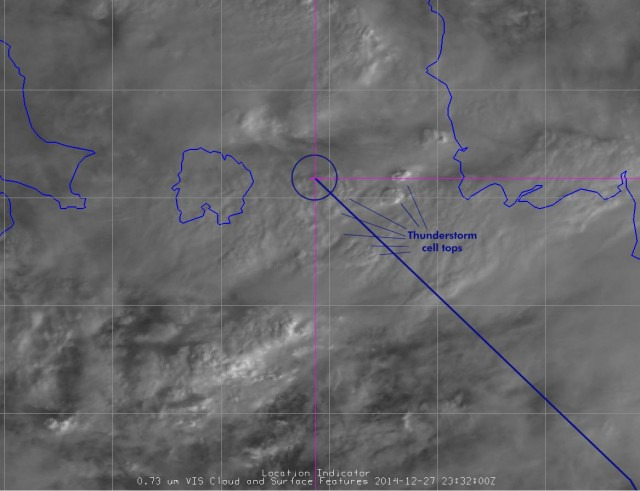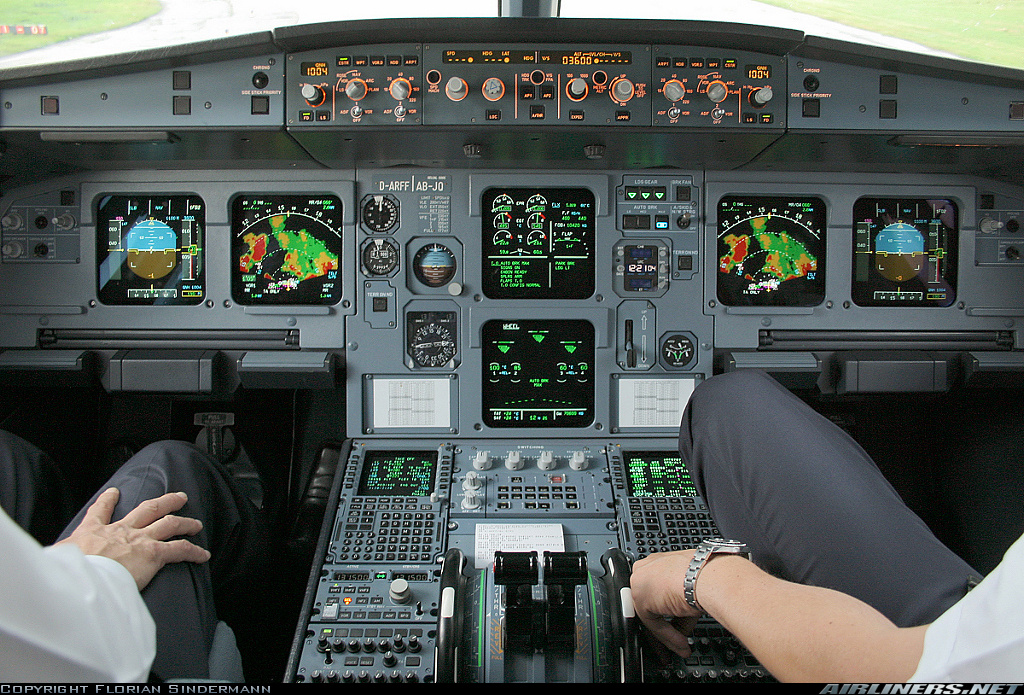Did Severe Thunderstorms Cause The Disappearance Of Flight QZ8501?
Aviation experts, meteorologists, and pilots put in their two cents about what could have happened when AirAsia Indonesia's QZ8501 lost contact with air traffic control and seemingly disappeared into thin air.
The AirAsia Indonesia flight QZ8501 remains missing as Day 2 of search and rescue (SAR) efforts continue, yet the key question remains: What happened?
An AirAsia A320 plane takes off from Malaysia’s Kuala Lumpur International Airport in May.
Image via Associated PressMost aviation experts agree that the stormy weather might have played a role in the plane's sudden disappearance, noting that the pilot requested to increase altitude to avoid the clouds prior to losing contact with air traffic control
The crew had requested to increase altitude to 38,000ft from 32,000ft to avoid clouds. Thunderstorms were reported in the area, with clouds up to 50,000ft, Indonesian officials said.
Flight-tracking website Flightradar24 said the jet was flying at the regular cruising altitude for most jetliners, 32,000ft, when the signal was lost. No distress reports came from the plane, officials said.
While there is no clear indication of what happened to the jet and what caused its disappearance, Michael Palmer - lead forecaster at The Weather Channel - said, "There were numerous showers and hail throughout the Java Sea and the flight path."
The large clusters of thunderstorms, some as tall as 50,000 feet, would have forced a pilot to change course, he added. The flight "could have run into turbulence and hail. We don't know if it was the cause but certainly the weather was not calm," Palmer added.
The maneuver could have been made to avoid thunderstorms or turbulence, but former pilots say it is safer to fly around storms rather than through them or over the top of the storm
Former pilots say it's best to try to go around thunderstorms instead of flying into them.
"Generally you want to pass upwind of a thunderstorm, because otherwise you're going to pick up more turbulence (than) if you went to the other side of the storm," Alastair Rosenschein, a former pilot, told CNN.
But flying over the top of the storm may not have been a feasible strategy, according to Rosenschein.
"You try and avoid thunderstorms by flying around them, not really by going over the top of them," he said. "That's not possible in the tropics."
While planes can handle very heavy rain, the number of lightning strikes recorded near the path of QZ8501 around the time it disappeared may have caused "dangerous turbulence" due to "significant updrafts and downdrafts"
A company that tracks worldwide weather conditions says a number of lightning strikes occurred near the path of Flight 8501 around the time it disappeared.
Bob Marshall, CEO and founder of Earth Networks, told CNN on Sunday that lightning indicates a significant number of thunderstorms.
"Planes can handle very heavy rain," he said. "That's not the issue. The issue is where are the tiny, small pockets of those storms that have significant updrafts and downdrafts that cause dangerous turbulence that can cause real problems for the pilots? That's what the lightning information tells you. The lightning allows you to kind of bore through the clouds and see the details of the storm and provides guidance to pilots on how to avoid it."
Though it is highly unlikely for a lightning strike to cause serious structural damage to an aircraft, it can disrupt the navigation systems while resulting turbulence from storms could potentially cause the aircraft's engine to shut down
While it is rare for a lightning strike to cause serious structural damage that threatens the safety of an aircraft, it can disrupt navigation systems such as magnetic compasses. A lightning flash, particularly at night, can also momentarily disorient pilots.
The turbulence associated with a big storm can sometimes be severe and sudden shifts in wind direction could disrupt the airflow through a jet engine, potentially causing it to shut down.
However, a shutdown of all engines in such a scenario would be highly unlikely and the Airbus A320 is certified to fly up to three hours on a single engine, in compliance with global aviation safety regulations.
However, aviation expert Captain Mike Vivian and meterologist Karen Maginnis noted that thunderstorms are not uncommon in the region due to the monsoon season. Pilots would have been aware and trained to respond to these weather conditions.
total precipitable water in the atmosphere shows a broad area of deep moisture in the vicinity of Indonesia (top left corner) during the past few days.
Image via Tim Vasquez / MashableAccording to Captain Vivian, storms can tower thousands of feet high and the thunder clouds can cause serious damage to aircraft. However, the weather conditions are not uncommon in the area and pilots are expert at navigating them, so it was unlikely that a sudden weather event caused the plane to go missing.
The region has been plagued by heavy rain and severe flooding in recent weeks -- something that the pilots should have been acutely aware of and trained to respond to, according to Maginnis.
"It is typical they would encounter monsoon weather," Maginnis said. "They (the pilots) would have had monsoon training."
"In a monsoonal season, you will get the heavy precipitation supercells," Maginnis said. "We have seen torrential rainfall -- even from Malaysia and Indonesia standards. We have seen incredible and fierce flooding across this region over the last several weeks."
Speaking to several check captains, aviation expert Geoffrey Thomas believes that the pilot might have flown too slow in his efforts to avoid the bad weather, thus inducing an aerodynamic stall which caused the Air France 447 crash in 2009
Brazil's navy recovers debris from the Air France plane which plunged into the Atlantic ocean in 2009.
Image via AP / Daily Mail UKGeoffrey Thomas, aviation expert and editor of airlineratings.com, spoke to several check captains and believes the pilot of the QZ8501 encountered difficult weather conditions but flew too slow in his efforts to avoid it.
The Air France AF447 crashed into the Atlantic Ocean in 2009 while en route from Rio de Janeiro to Paris.
“The QZ8501 was flying too slow, about 100 knots which is about 160km/h too slow. At that altitude that’s exceedingly dangerous,” Mr Thomas said. “I have a radar plot which shows him at 36,000 feet and climbing at a speed of 353 knots, which is approximately 100 knots too slow ... if the radar return is correct, he appears to be going too slow for the altitude he is flying at.”
Mr Thomas said this should not happen in an A320, a sophisticated aircraft, so it appears as though it’s related to extreme weather conditions.
“He got caught in a massive updraft or something like that. Something’s gone terribly wrong,” he said. “Essentially the plane is flying too slow to the altitude and the thin air, and the wings won’t support it at that speed and you get a stall, an aerodynamic stall.”
Former US Air Force meteorologist Tim Vasquez's analysis also shows similarities to the Air France incident, as both the QZ8501 and Air France flights encountered severe storms at cruising altitudes and disappeared without warning
Analysis of the last known position of AirAsia Flight 8501 and weather conditions at the time, as plotted by meteorologist Tim Vasquez.
Image via Tim Vasquez / MashableTim Vasquez, a former U.S. Air Force meteorologist who now runs a weather-consulting business, posted several plots of the flight path of AirAsia Flight 8501. Vasquez, who exhaustively chronicled weather's likely role in the Air France crash, also shared satellite images that showed there were intense thunderstorms along the plane's route at the time that radar contact was lost.
His analysis shows eerie similarities to the Air France incident, since both flights encountered severe storms while at their cruising altitudes, and disappeared without warning. In the Air France incident, airspeed indicators known as pitot tubes became iced over, and delivered inaccurate airspeed data to the aircraft's flight control system.
Unlike Air France's case, though, the AirAsia incident occurred during daylight, which might've given pilots more visual cues about their airspeed and the attitude of the aircraft (whether it was angled up or down).
Ice buildup on the aircraft's external sensors (known as "icing" in aviation) may also have played a role in the incident as the plane flies through supercooled water in the upper layers of thunderstorms
"Cloud tops almost certainly extended to above 50,000 feet," Vasquez wrote in a blog post published on Sunday.
The thunderstorms that Flight 8501 likely encountered began off the southwest coast of Borneo, according to Vasquez, with cloud tops reaching between 47,000 feet to 52,000 feet above ground level. This means the plane, which was cruising at a lower altitude than that, was flying through clouds containing ice — either in the form of ice crystals or supercooled water droplets, which are water droplets that freeze on contact, or both.
His conclusion, which is solely based on an analysis of meteorological conditions at the time of the incident, is that weather played a contributing role. "The most likely hazard, if weather was a factor, appears to be icing," Vasquez wrote. "This is only an assessment of best available meteorological information, and is not a final determination on the cause of the incident."
When ice fragments dislodge, they can cause the engine to lose power or shut down.
Image via NASA / Eric MindekThe plane could have flown into icy conditions which may have caused it to stall and "drop out of the sky", according to pilot Ray Karam Singh, who is familiar with the route over the Java Sea.
He said the pilot of the QZ8501 could have been attempting to fly out of icy conditions by going higher but could have encountered further issues with the ice.
Mr Singh told Sky News he thought ice was the most likely cause, rather than thunderstorms.
Besides poor weather conditions, the QZ8501's disappearance could also be attributed to the outdated radar the aircraft model - an Airbus A320-216 - is equipped with
The A320, while sophisticated, is not equipped with the latest radar, Mr Thomas said. The radar used by the A320 can sometimes have problems in thunderstorms and the pilot may have been deceived by the severity of these particular ones.
The latest technology radars, which were pioneered by Qantas in 2002, can give a more complete and accurate reading of a thunderstorm, but they haven’t been certified for the A320 until next year.
“If you don’t have what’s called a multiskilled radar you have to tilt the radar yourself manually, you have to look down to the base of the thunderstorm to see what the intensity of the moisture and the rain is, then you make a judgment of how bad it is. It’s manual, so it’s possible to make a mistake, it has happened,” Mr Thomas said
Another possible theory points to deliberate action from a party that is not the piloting crew, such as that of a terrorist act. However, US agents have since confirmed that they found no signs of terrorist threat.
The pilots of the AirAsia plane maintained communication with air traffic control until the very last minute, according to David Learmount, the operations and safety editor of Flight Global.
The pilot's mantra is to aviate, navigate and then communicate. Therefore, something distracted them and meant they were unable to speak to air traffic control.
Mr Learmount said: "Something distracted their attention so they were no longer able to keep talking. We don't know what happened at the moment, and it doesn't appear to be a deliberate act."
The theory that the QZ8501 passengers were victims of a terrorist attack has also surfaced on the internet, much like in the aftermath of MH370.
But soon after the plane disappeared, US agents scoured through its latest intelligence and found no signs of a terrorist threat or "other foul play", the New York Times reported.








